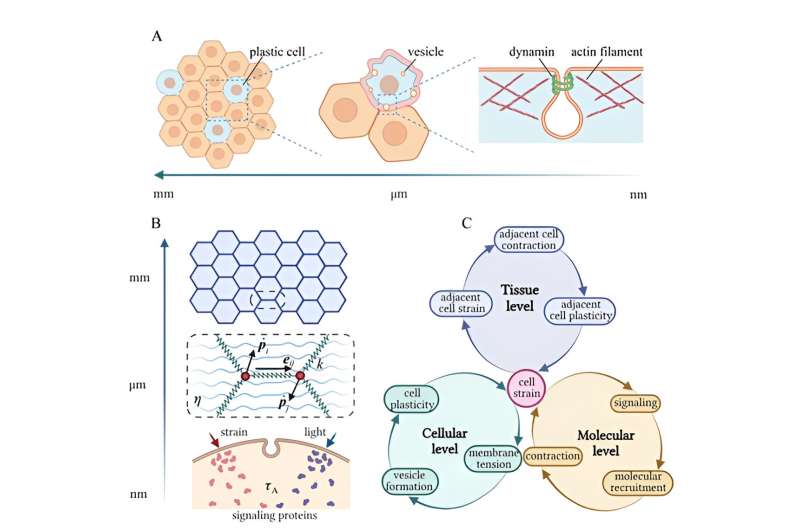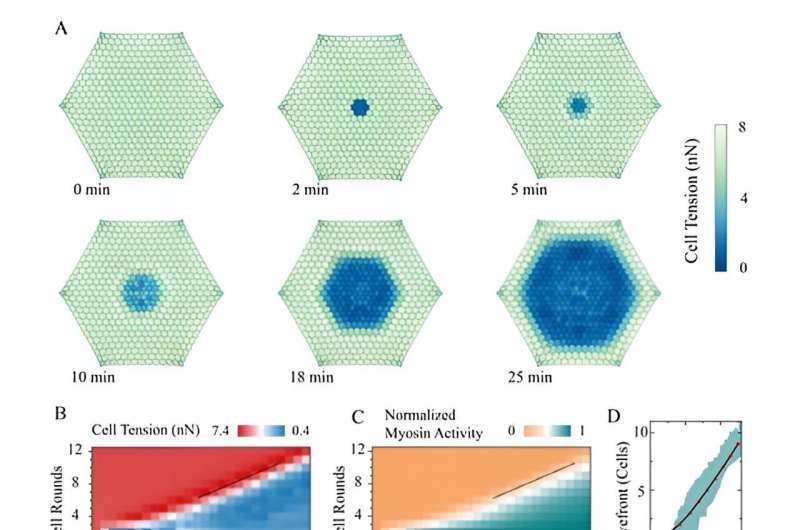This article has been reviewed according to Science X's editorial process and policies. Editors have highlighted the following attributes while ensuring the content's credibility:
fact-checked
trusted source
proofread
A mechanism-based theory of cellular and tissue plasticity

Cells and tissue are known to undergo significant irreversible deformations during processes such as tissue formation and embryo development. A research team led by Professor Yuan Lin from the Department of Mechanical Engineering at the University of Hong Kong (HKU) has made a major new breakthrough in showing how plastic strain develops in individual cells and then propagates within the tissue.
The study, titled "A Mechanism-Based Theory of Cellular and Tissue Plasticity," has been published in the Proceedings of the National Academy of Sciences (PNAS).
"By revealing the biophysical mechanisms behind the development of cellular and tissue plasticity at different scales, the study is a big step in advancing our understanding of processes such as organ formation and embryogenesis," said Professor Lin. The theoretical framework developed could also provide critical insights for designing innovative strategies in regenerative medicine.
Morphogenesis, the process by which tissues, organs, and organisms acquire complex three-dimensional geometries, involves numerous cells deforming in a highly coordinated and programmed manner. Recent studies have shown that such deformation is often irreversible. But just how cellular and tissue plasticity are developed, as well as the biophysical mechanisms behind them, has hitherto remained a mystery to scientists.
In collaboration with researchers from Nanyang Technological University of Singapore, Professor Lin and his team, including Mr. Fuqiang Sun, Dr. Chao Fang and Dr. Xueying Shao, developed a multi-scale theory, the first of its kind, to show that in response to optical or mechanical stimuli, the myosin contraction and thermal fluctuation-assisted formation and pinching of endocytic vesicles could lead to the permanent shortening of cell junctions (Fig. 1).
Such plastic constriction can stretch neighboring cells and trigger their active contraction through mechanochemical feedbacks and their irreversible deformation, ultimately resulting in the propagation of plastic deformation waves within the tissue (Fig. 2).

The theory predicts that endocytic vesicles with a size of about 1–2 µm will most likely be formed. A greater irreversible shortening of cell junctions can be achieved if a long stimulation is split into multiple short ones and the plastic constriction wave propagates at a constant speed within the cell monolayer, all in quantitative agreement with experimental observations.
Professor Lin's team is among world leaders in the study of cell plasticity and its role in different biological processes. For example, they were the first to show how cellular anisotropy and plasticity facilitate the proper elongation of developing embryos. They have also demonstrated that the capability of tumor cells to undergo plastic deformations is directly correlated with their metastatic potential. This earlier research has been published in Science Advances and Physical Review Letters.
More information: Fuqiang Sun et al, A mechanism-based theory of cellular and tissue plasticity, Proceedings of the National Academy of Sciences (2023). DOI: 10.1073/pnas.2305375120
Provided by The University of Hong Kong




















